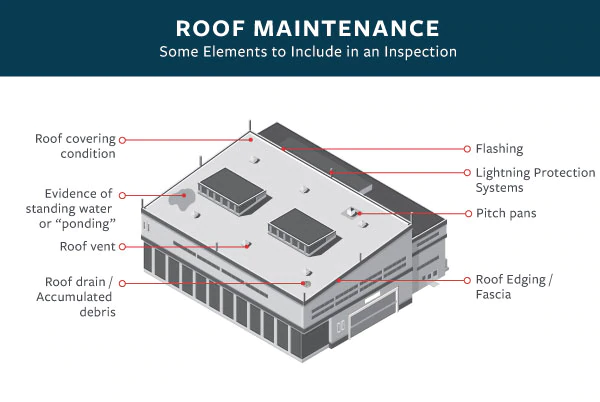
Michael Fried is the President and Kyle Herring is the Vice President of All American Public Adjusters in Austin.
When it comes to severe weather in Texas, we may get off easy during the fall and winter months, but spring and summer are another story. Storms with damaging winds and hail blow through the Lone Star State from March through November, leaving billions of dollars of destruction in their wake. In 2019 alone, NOAA reported 182 tornadoes and more than 500 hail events in Texas.

For many Texas commercial property owners, dealing with roof damage from hail and high winds is simply a part of doing business. You may have an active insurance claim on a building right now, or perhaps you’ve grappled with the issue in the past. Even if you’ve been lucky enough to have emerged unscathed from previous storm seasons, your roof has definitely been hit with hail before and will eventually be compromised.

How you navigate your insurance coverage and submit your claim for storm-related roof damage can make the difference between enjoying continued success and taking a significant financial hit when it’s time for a roof repair or replacement. Here are three things to consider to avoid common mistakes and achieve optimal results:
1. Code Upgrades
So, your roof took a beating in a recent hailstorm, and now it needs to be brought into compliance with energy efficiency and safety codes as part of the repair. It might sound like a hassle, but making these improvements is actually a smart ownership decision. Common code upgrades for roof rehabilitation include installing new above-deck thermal insulation per the International Energy Conservation Code (IECC), replacing old R-22 air-conditioner units with 410-A models based on new EPA freon regulations, or even having to remove multiple existing roof layers down to the deck and bringing the roof up to energy code.
The good news is, while insurance policies generally cover “like for like” replacements and repairs, additional coverage does exist for the cost of bringing structures up to code. However, it’s advisable to review your policy and ensure you have adequate code-upgrade coverage to avoid getting stuck with the bill for high-cost improvements. A basic unendorsed commercial property policy only includes $10k for code upgrades. If you had to add above-deck insulation to a 200,000-square-foot facility, your coverage would be nowhere near what’s required to bring it up to code. In this case, you might need to pivot your loss measures to maximize your benefits as much as possible.
Additionally, you’ll need a team of experts on your side to coordinate and certify the details of your insurance claim to successfully secure code upgrade coverage. Most policies have what they call “professional fees” coverage for the costs of hiring experts such as forensic engineers, meteorologists, thermal drone companies and testing laboratories. It’s critical to review your policy coverage and risk mitigation plan now to proactively address these issues.
2. Cosmetic damage exclusion
In a nutshell, a cosmetic damage exclusion is this: if a hailstorm impacts your metal roof and causes a dent, and that dent does not reduce the roof’s ability to shed water, your policy will not cover the damages. Even if your roof has sustained functional damage to the structure, if you don’t take the right steps and consult the appropriate professionals when submitting your claim, you might get slapped with a cosmetic denial by your insurance company. Proving that the damage isn’t just cosmetic requires expert analysis and rigorous testing procedures that follow ASTM standards.
With a damaged metal roof, for example, you as the property owner would need to enlist the help of a forensic engineer and a metallurgist who will take samples of the damaged area and submit them for destructive testing and other analyses in an ASTM-certified testing laboratory. There is a proper methodology for documenting the chain of custody for samples when submitting a claim or protesting a cosmetic denial, so everyone involved in sampling and testing should know these procedures and follow them meticulously. With so many moving parts, it’s extremely beneficial to hire a qualified, reputable public adjuster to enact a plan and coordinate the retention of all of these experts so you can remain focused on your business.
3. Business continuity
When you need to replace or repair your roof, you probably can’t shut down your business for two weeks and claim the income loss. As part of your overall business continuity plan, review your policy to ensure you have adequate “extra expense” coverage to help keep your business up and running during a roofing project while reducing your net income loss claim (this is key). These extra expenses might include payroll for overtime hours, extra lighting for an overnight crew, or the installation of temporary A/C units so the damaged ones can be replaced while not shutting down your business.
Additionally, if your business continues operating during construction, you must follow proper Occupational Safety and Health Administration health and safety guidelines. From pedestrian walkways, to debris shoots and other considerations, ensure these expenses are included as part of a comprehensive business continuity plan that’s tailored to the coverage within your specific policy.
Dealing with roof damage from hail and high wind can be a stressful situation for any property owner. But by taking a proactive approach to your mitigation and business continuity planning, understanding the details of your coverage and having the right team of experts at your side, it’s possible to maximize the benefits of your commercial property insurance package during storm season in Texas.




